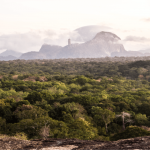Meeting E. O. Wilson
By Inessa Voet
On Tuesday the 15th of May, the Antonelli group sat gathered in a room, excitingly awaiting Professor Wilson’s appearance. He suddenly walked into the doorway, and, without further ceremony, said hello and went to sit down. Greeted with smiles and looks of awe, the most surprising first impression was that of a humble man, despite being the most cited author in scientific literature. After an introduction and a few words of gratitude for accepting to meet with the group, the first question was asked. What was initially meant as an interview became a chat, as we all listened to his answers, followed by passionate anecdotes from his life’s work. Here are a few of both, which I hope to convey with accuracy.
For our first query, we asked what were, according to him, the most important biodiversity questions still unanswered. Without having to think, he immediately said that the key to understanding and preserving our world resided in the study of individual species, in order to shed light on the functioning of ecosystems. He insisted on the fact that not only must we discover the remaining 8 million estimated unknown species, but also give them a name, and find out everything there is to know about them. That is a necessary step on the way to measuring, and perhaps being able to counter extinction. Smiling knowingly at the whole group, he added that, shall one want to make a name for oneself, the study of those mysterious species, such as members of the Protura order, would be a good place to start. Reading our thoughts, he added “and if you say they are too obscure, let me tell you, that’s your job, to make them less obscure.”
We then enquired about his opinion on the role of a biologist in politics. To that, his answer was quite short. He said that you might not want to get involved, but you have to, if you want to change anything. I don’t believe any of us disagrees on that matter.
Changing subjects completely, the next question seemed to bring back many memories. One of Professor Wilson’s most remarkable abilities lays in the quantity and quality of his articles, books, and other published works. Therefore, our question was “How do you write?” To that, he smiled, and answered, “Write about what you love. Make a story out of it.” At age 88, he has published multiple books, and is currently writing two more. Genesis: The Deep Origin of Societies in which he aims to describe the selection forces involved in the emergence of societies. In the second (the title of which has not been fixed yet), he is exchanging with a group of naturalists working on similar subjects to report ant stories. Among the war stories, he described the viciousness of Camponotus femoratus, a very particular species of ant from the Amazon forest understory, insisting it is the most aggressive of all ants. This species is very particular, bringing up soil and seeds, raising other organisms, and using these gardens and “cattle” as a primary food source. When approached, the colony will do everything in its power to protect their riches, even against predators as relatively huge as us. The slightest whiff of a threat, and they go wild with aggression, snapping, and spraying formic acid. Wilson states there is a reason behind this display of violence. “The more valuable the resource you have, the more important it is to protect it, the more vicious you become.”
He passed onto another anecdote, this time about the Collembola hunters. Collembola are a group of insect- like organisms, no longer considered insects, but a sister group. Most Collembola species have a lever on their abdomen (the furcula) held down by an extremely powerful spring system (the retinaculum). When the tension is released, they are launched into the air by the sheer force of it, and can escape predation by this unusual method. Some ant species, the dacetine ants, are Collembola hunters, and both predator and prey have co-evolved to develop highly sensitive systems, enabling them to detect, and capture or evade one another. The ants possess sharp mandibles, and 2 sensorial hairs emerging from the labrum. When they are close enough, the sensorial hairs touch, and the mandibles come together in the fastest known movement within the animal kingdom. It is a gunshot race start, in which the latecomer has a lot to lose. Other than the obvious being caught or coming home empty-handed, a third situation may come to be, when the ant was only slightly slower than the Collembola. The lever has already been released, followed in a fraction of a second by the ant’s response. The force of the prey’s propulsion is enough to send them both flying in mid air. We can only imagine what happens next.
The last question we asked enquired whether there were any study subjects today’s scientists were wasting their time on. He laughed, saying he had never been asked this question before. He smiled once more, and stated that, have they decided to spend so much time to study those subjects, it can in no way be a waste.
He concluded the meeting by saying he had things to get back to, understandingly with two more books on the way, and received both a thank you card with an ant picture (immediately identified as Formica rufa) and the first honorary membership certificate from the GGBC, the new Gothenburg Global Biodiversity Centre. The last thing he said, before leaving the room, was “I would come back to Sweden, except for the fact that you don’t have enough ant species.” Laughter followed him as he made his way back to his office.
Inessa Voet, Master student under the supervision of Søren Faurby and Daniele Silvestro
